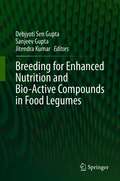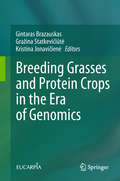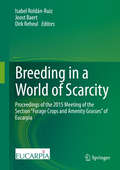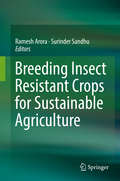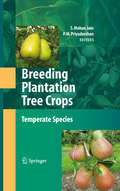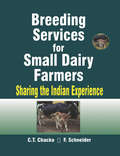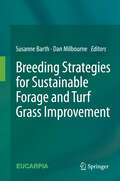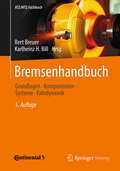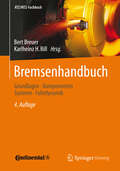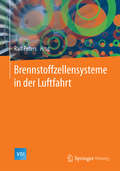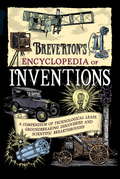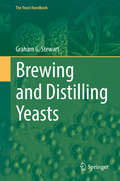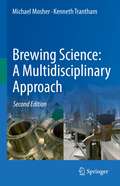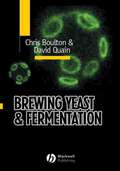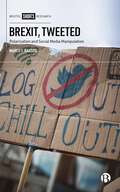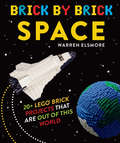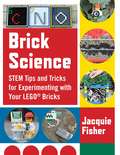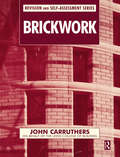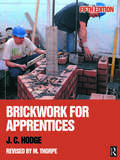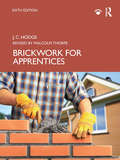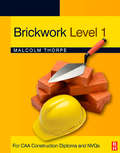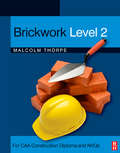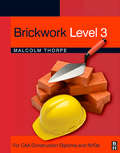- Table View
- List View
Breeding for Enhanced Nutrition and Bio-Active Compounds in Food Legumes
by Debjyoti Sen Gupta Sanjeev Gupta Jitendra KumarMore than 20 million childhood deaths occur every year due to the micronutrient deficiency and diet-related non-communicable diseases (cardiovascular diseases, cancers, chronic respiratory diseases and diabetes). The United Nations (UN) recently announced that the increase in chronic, non-communicable diseases has resulted in 36 million deaths around the world annually, claiming more lives than all other causes combined. These chronic diseases are not isolated to developed countries and are even more pronounced in the developing world. Such chronic illnesses have caused far more deaths than infectious diseases throughout the world (except Africa) in recent years. Therefore, enrichment of micronutrients in staple food crops is of paramount importance for the nutritional security in our world. Biofortification is the development of micronutrient- and/or vitamin-rich crops using traditional crop improvement practices as well as modern biotechnology tools. It is a more sustainable and cost effective method than food supplementation, fortification and diet diversification. This work consolidates available information on the different aspects of breeding for improved nutrition of pulses. An overview of entire pulses based on their nutritional profile is given so that audience can find the desired information easily. Food legumes are the active ingredients in many gluten-free food products and there is a continuous rise of the use of pulses flour in milling and baking processes. Our book sheds light on recent efforts and the underlying constraints of meeting the public demand. We believe this work provides the basic information for anyone interested in biofortification and stimulate further research to meet this unique challenge.
Breeding Grasses and Protein Crops in the Era of Genomics
by Kristina Jonavičienė Gražina Statkevičiūtė Gintaras BrazauskasThis book includes papers presented at the 2017 Joint meeting of Fodder Crops and Amenity Grasses Section and Protein Crops Working Group of EUCARPIA-Oil and Protein Crops Section. The theme of the meeting “Breeding Grasses and Protein Crops in the Era of Genomics” has been divided into six parts: (1) Utilisation of genetic resources and pre-breeding, (2) Genetic improvement of quality and agronomic traits, (3) Breeding for enhanced stress tolerance (4) Implementation of phenomics and biometrics, (5) Development of genomic tools and bioinformatics and (6) Reports of Parallel Sessions.
Breeding in a World of Scarcity: Proceedings of the 2015 Meeting of the Section “Forage Crops and Amenity Grasses” of Eucarpia
by Isabel Roldán-Ruiz Joost Baert Dirk ReheulThis book includes papers presented at the 2015 meeting of the Fodder Crops and Amenity Grasses Section of Eucarpia. The theme of the meeting "Breeding in a world of scarcity" was elaborated in four sessions: (1) scarcity of natural resources, (2) scarcity of breeders, (3) scarcity of land and (4) scarcity of focus. Parts I to IV of this book correspond to these four sessions. Session 1 refers to the consequences of climate change, reduced access to natural resources and declining freedom in using them. Plant breeding may help by developing varieties with a more efficient use of water and nutrients and a better tolerance to biotic and abiotic stresses. Session 2 refers to the shrinking number of field breeders. There is a need for a mutual empathy between field- and lab-oriented breeding activities, integrating new methods of phenotyping and genotyping. Session 3 underscores the optimal use of agricultural land. Forage needs to be intensively produced in a sustainable way, meeting the energy, protein and health requirements of livestock. Well-adapted varieties, species and mixtures of grasses and legumes are needed. Session 4 refers to the fading of focus in primary production triggered by a range of societal demands. There are few farmers left and they are asked to meet many consumer demands. Both large-scale, multi-purpose species and varieties and specialized niche crops are required. Part V summarizes the conclusions of two open debates, two working group meetings and two workshops held during the conference. The debates were devoted to the future of grass and fodder crop breeding, and to feed quality breeding and testing. The conference hosted meetings of the working groups "Multisite rust evaluation" and "Festulolium". Workshops focused on "genomic selection and association mapping" and on "phenotyping" with applications in practical breeding research. Part V contains also short sketches of breeding ideas presented as short communications.
Breeding Insect Resistant Crops for Sustainable Agriculture
by Ramesh Arora Surinder SandhuThis book reviews and synthesizes the recent advances in exploiting host plant resistance to insects, highlighting the role of molecular techniques in breeding insect resistant crops. It also provides an overview of the fascinating field of insect-plant relationships, which is fundamental to the study of host-plant resistance to insects. Further, it discusses the conventional and molecular techniques utilized/useful in breeding for resistance to insect-pests including back-cross breeding, modified population improvement methods for insect resistance, marker-assisted backcrossing to expedite the breeding process, identification and validation of new insect-resistance genes and their potential for utilization, genomics, metabolomics, transgenesis and RNAi. Lastly, it analyzes the successes, limitations and prospects for the development of insect-resistant cultivars of rice, maize, sorghum and millet, cotton, rapeseed, legumes and fruit crops, and highlights strategies for management of insect biotypes that limit the success and durability of insect-resistant cultivators in the field. Arthropod pests act as major constraints in the agro-ecosystem. It has been estimated that arthropod pests may be destroying around one-fifth of the global agricultural production/potential production every year. Further, the losses are considerably higher in the developing tropics of Asia and Africa, which are already battling severe food shortage. Integrated pest management (IPM) has emerged as the dominant paradigm for minimizing damage by the insects and non-insect pests over the last 50 years. Pest resistant cultivars represent one of the most environmentally benign, economically viable and ecologically sustainable options for utilization in IPM programs. Hundreds of insect-resistant cultivars of rice, wheat, maize, sorghum, cotton, sugarcane and other crops have been developed worldwide and are extensively grown for increasing and/or stabilizing crop productivity. The annual economic value of arthropod resistance genes developed in global agriculture has been estimated to be greater than US$ 2 billion Despite the impressive achievements and even greater potential in minimizing pest- related losses, only a handful of books have been published on the topic of host-plant resistance to insects. This book fills this wide gap in the literature on breeding insect- resistant crops. It is aimed at plant breeders, entomologists, plant biotechnologists and IPM experts, as well as those working on sustainable agriculture and food security.
Breeding Plantation Tree Crops: Temperate Species
by P. M. Priyadarshan Shri Mohan JainTree species are indispensable to human needs. Due to their long life cycle and environmental sensitivity, breeding trees for sustainable production is a formidable challenge in order to meet the demands of growing human population and industries. Fruit crops such as apple, cocoa, mango, citrus, litchi, pear, dates, and coconut or industrial crops including rubber and tea, improving yield under the optimal, sub-optimal and marginal areas call for a unified worldwide effort. While the uniqueness of coconut as 'kalpavriksha' (Sanskrit - meaning tree of life) makes its presence in every continent from Far East to South America, tree crops such as cocoa, oil palm, rubber, apple, peach and walnut prove their environmental sensitivity towards tropical, subtropical and temperate climates. Date palm is quintessential for desert climate. Thus, from soft drinks to breweries to oil to tires, the value addition offers a spectrum of products to human kind, enriched with nutritional, environmental, financial, and trade related attributes. This volume is a compilation of information on breeding of temperate tree species and provides first hand comprehensive knowledge to research, teach, and make policies.
Breeding Services for Small Dairy Farmers: Sharing the Indian Experience
by C T ChackoBetter validation of indigenous domestic animal genetic resources is becoming more important with regard to the potential of livestock for poverty alleviation and income generation. To improve indigenous breeds for sustainable income and employment generation, the methods to be employed are the same as developed in systematic breeding programs, be it for cross-breeding or selective breeding within a specific breed. This book systematically introduces the reader to the breed improvement theory and illustrates the theory with practical examples and case studies. The book is addressed to animal science teachers, to undergraduate and postgraduate students as well as to decision makers in the state and central livestock departments.
Breeding strategies for sustainable forage and turf grass improvement
by Dan Milbourne Susanne BarthFrom the 4th - 8th of September 2011, the Eucarpia Fodder Crops and Amenity Grasses Section, held its 29th Meeting in the surroundings of Dublin Castle in Ireland. The theme of the meeting was 'Breeding strategies for sustainable forage and turf grass improvement'. Grasslands cover a significant proportion of the land mass of the world, and play a pivotal role in global food production. At the same time we are faced with several challenges that affect the way in which we think about this valuable set of resources. The population of the world is expected to exceed 9 billion by 2050, and increase of about one third relative to today's levels. This population increase will be focused in urban areas, and in what are currently viewed as "developing" countries, meaning that the buying power of this increased population will be greater - shifting the balance of demand from staple crops to high value items such as meat and dairy products. Overall that the world will have to approximately double agricultural output across all categories of food to meet the demands of this larger, urbanised population. This is occurring against a backdrop of equally large challenges in terms of global climate change. Agriculture is already a significant contributor to e.g. greenhouse gas emissions, deforestation and soil erosion. The situation is made more complex by an increased emphasis on biofuels as a solution for our imminent oil shortage, resulting in increased competition between land utilised for food and fuel. In short, agriculture must continue to feed the world, whilst not contributing to damaging it further. It must be sustainable. Plant breeding plays a significant but frequently understated role in meeting the challenges presented by this complex and changing scenario. However, plant breeding and improvement is itself undergoing radical change driven by technology. This book explores how forage and turf breeding is changing and adapting to meet these challenges using the technological advances being experienced in plant breeding as a whole.
Bremsenhandbuch: Grundlagen, Komponenten, Systeme, Fahrdynamik (ATZ/MTZ-Fachbuch)
by Bert Breuer Karlheinz H. BillDas Bremsenhandbuch erm#65533;glicht einen tiefen Einblick in den heutigen Stand, die Potentiale und die zuk#65533;nftige Entwicklung von Kraftfahrzeugbremsanlagen. Mikroelektronik und Mechatronik haben das technische Potential und die Funktionalit#65533;t von Bremsanlagen enorm gesteigert. Hydraulisch, elektrohydraulisch oder elektromechanisch bet#65533;tigte Bremsen und die gesamte Bremsanlage mit all ihren Komponenten sind ein unverzichtbarer Teil des heute bereits erreichten bzw. zuk#65533;nftig noch m#65533;glichen Niveaus der Sicherheit, der Fahrerassistenz und der Unfallvermeidung. Das Bremsenhandbuch behandelt umfassend Grundlagen, Anforderungen, Auslegung, Simulation, Komponenten, Systeme, Betriebsverhalten und Funktionen im modernen Fahrzeug. Es ber#65533;cksichtigt dabei Personenwagen, Nutzfahrzeuge, Anh#65533;nger, Schienenfahrzeuge, gel#65533;ndeg#65533;ngige Rad- und Kettenfahrzeuge, Motor- und Fahrr#65533;der sowie Rennfahrzeuge und Flugzeuge. Diese dritte Auflage wurde gr#65533;ndlich #65533;berarbeitet, aktualisiert und z. B. durch neue Kapitel zu Bremssystemen von Schienenfahrzeugen, mechatronischen Systemen, mechanischen Bremsen in Industrieanlagen oder Bremsen mit nichtmetallischen Bremsscheiben erheblich erweitert. Einheitliche Formelzeichen wurden f#65533;r alle Kapitel eingef#65533;hrt.
Bremsenhandbuch: Grundlagen, Komponenten, Systeme, Fahrdynamik (ATZ/MTZ-Fachbuch)
by Bert Breuer Karlheinz H. BillDas Bremsenhandbuch ermöglicht einen tiefen Einblick in den heutigen Stand, die Potentiale und die zukünftige Entwicklung von Kraftfahrzeugbremsanlagen. Mikroelektronik und Mechatronik haben das technische Potential und die Funktionalität von Bremsanlagen enorm gesteigert. Hydraulisch, elektrohydraulisch oder elektromechanisch betätigte Bremsen und die gesamte Bremsanlage mit all ihren Komponenten sind ein unverzichtbarer Teil des heute bereits erreichten bzw. zukünftig noch möglichen Niveaus der Sicherheit, der Fahrerassistenz und der Unfallvermeidung. Das Bremsenhandbuch behandelt umfassend Grundlagen, Anforderungen, Auslegung, Simulation, Komponenten, Systeme, Betriebsverhalten und Funktionen im modernen Fahrzeug. Es berücksichtigt dabei Personenwagen, Nutzfahrzeuge, Anhänger, Schienenfahrzeuge, geländegängige Rad- und Kettenfahrzeuge, Motor- und Fahrräder sowie Rennfahrzeuge und Flugzeuge. Diese dritte Auflage wurde gründlich überarbeitet, aktualisiert und z.B. durch neue Kapitel zu Bremssystemen von Schienenfahrzeugen, mechatronischen Systemen, mechanischen Bremsen in Industrieanlagen oder Bremsen mit nichtmetallischen Bremsscheiben erheblich erweitert. Einheitliche Formelzeichen wurden für alle Kapitel eingeführt.
Brennstoffzellensysteme in der Luftfahrt (VDI-Buch)
by Ralf PetersDer Einsatz von Brennstoffzellensystemen im Flugzeug bietet die M#65533;glichkeit, die Funktionen Strom, Wasser- und Inertgaserzeugung mit Hilfe eines einzigen Systems zu gew#65533;hrleisten, Hilfssysteme (Wassertanks, die konventionelle APU und das FTIS) k#65533;nnen ebenso entfallen wie die zus#65533;tzliche Speicherung von Wasser. Generatoren und Batterien k#65533;nnen kleiner dimensioniert werden. Diese Ma#65533;nahmen verringern den Kraftstoffverbrauch, erh#65533;hen die Gesamteffizienz eines Flugzeuges und erm#65533;glichen einen emissionsarmen Betrieb von Flugzeugen im Flug und besonders am Boden. Die Autoren vergleichen Aspekte bei der Nutzung heutiger und zuk#65533;nftiger Kraftstoffe f#65533;r Brennstoffzellen in der Luftfahrt. Die Eigenschaften geeigneter Brennstoffzellentypen werden beschrieben und analysiert, es wird dabei dargestellt warum der Brennstoffzellentyp HT-PEFC besonders geeignet ist und welche Herausforderungen damit verbunden sind. Technische Entwicklungen, wie die HT-PEFC Stackentwicklung, die der Komponenten des Brenngaserzeugungssystems und der Aufbau und der Test eines 5 kWe HT-PEFC Gesamtsystems werden beschrieben. Das Buch schlie#65533;t mit der Betrachtung von Brennstoffzellensystemen als Bestandteil eines multifunktionalen Systems und dem Ausblick auf zuk#65533;nftige Anwendungen in der Luftfahrttechnik.
Breverton's Encyclopedia of Inventions
by Terry BrevertonInvention and innovation are what distinguish the human race from all of the other species on Earth. Throughout history the imagination and pioneering spirit of human kind has compelled us to question why we do things in a certain way and, more importantly, how we can do things better. Celebrating the ingenuity, creativity and resourcefulness that has led to some of the most amazing technological leaps through the ages, Breverton's Encyclopedia of Inventions examines the key innovations and breakthroughs of all time and the genius behind them.Starting with the building of the pyramids in ancient Egypt and the discovery of the solar system, moving through surgery, dynamite and rockets, to modern technology such as the smart card and genetic engineering, Terry Breverton springs many surprises. He uncovers fascinating and little-known facts: for example, that Price, not Fleming, discovered penicillin; that Swan, not Edison invented the electric light, and that Wallace, not Darwin first advanced the theory of evolution. Tracing the sheer persistence of brilliant men and women across the globe, who fought the prevailing ideas of their times and advanced technology, Breverton's Encyclopedia of Inventions will inspire anyone interested in the history and developments that have changed our lives and shaped our planet's future.
Breverton's Encyclopedia of Inventions: A Compendium of Technological Leaps, Groundbreaking Discoveries and Scientific Breakthroughs that Changed the World
by Terry BrevertonInvention and innovation are what distinguish the human race from all of the other species on Earth. Throughout history the imagination and pioneering spirit of human kind has compelled us to question why we do things in a certain way and, more importantly, how we can do things better. Celebrating the ingenuity, creativity and resourcefulness that has led to some of the most amazing technological leaps through the ages, Breverton's Encyclopedia of Inventions examines the key innovations and breakthroughs of all time and the genius behind them. Starting with the building of the pyramids in ancient Egypt and the discovery of the solar system, moving through surgery, dynamite and rockets, to modern technology such as the smart card and genetic engineering, Terry Breverton springs many surprises. He uncovers fascinating and little-known facts: for example, that Price, not Fleming, discovered penicillin; that Swan, not Edison invented the electric light, and that Wallace, not Darwin first advanced the theory of evolution. Tracing the sheer persistence of brilliant men and women across the globe, who fought the prevailing ideas of their times and advanced technology, Breverton's Encyclopedia of Inventions will inspire anyone interested in the history and developments that have changed our lives and shaped our planet's future.
Breverton's Encyclopedia of Inventions: A Compendium of Technological Leaps, Groundbreaking Discoveries and Scientific Breakthroughs that Changed the World
by Terry BrevertonInvention and innovation are what distinguish the human race from all of the other species on Earth. Throughout history the imagination and pioneering spirit of human kind has compelled us to question why we do things in a certain way and, more importantly, how we can do things better. Celebrating the ingenuity, creativity and resourcefulness that has led to some of the most amazing technological leaps through the ages, Breverton's Encyclopedia of Inventions examines the key innovations and breakthroughs of all time and the genius behind them. Starting with the building of the pyramids in ancient Egypt and the discovery of the solar system, moving through surgery, dynamite and rockets, to modern technology such as the smart card and genetic engineering, Terry Breverton springs many surprises. He uncovers fascinating and little-known facts: for example, that Price, not Fleming, discovered penicillin; that Swan, not Edison invented the electric light, and that Wallace, not Darwin first advanced the theory of evolution. Tracing the sheer persistence of brilliant men and women across the globe, who fought the prevailing ideas of their times and advanced technology, Breverton's Encyclopedia of Inventions will inspire anyone interested in the history and developments that have changed our lives and shaped our planet's future.
Brewing and Distilling Yeasts (The Yeast Handbook)
by Graham G. StewartThis book is an overview considering yeast and fermentation. The similarities and differences between yeasts employed in brewing and distilling are reviewed. The implications of the differences during the production of beer and distilled products (potable and industrial) are discussed. This Handbook includes a review of relevant historical developments and achievements in this field, the basic yeast taxonomy and biology, as well as fundamental and practical aspects of yeast cropping (flocculation), handling, storage and propagation. Yeast stress, vitality and viability are also addressed together with flavor production, genetic manipulation, bioethanol formation and ethanol production by non-Saccharomyces yeasts and a Gram-negative bacterium. This information, and a detailed account of yeast research and its implications to both the brewing and distilling processes, is a useful resource to those engaged in fermentation, yeast and their many products and processes.
Brewing Science: A Multidisciplinary Approach
by Michael Mosher Kenneth TranthamThis updated text collects all the introductory aspects of beer brewing science into one place for undergraduate brewing science courses. This expansive and detailed work is written in conversational style, walking students through all the brewing basics from the origin and history of beer to the brewing process to post-brew packaging and quality control and assurance. As an introductory text, this book assumes the reader has no prior knowledge of brewing science and only limited experience with chemistry, biology and physics. The text provides students with all the necessary details of brewing science using a multidisciplinary approach, with a thorough and well-defined program of in-chapter and end-of-chapter problems. As students solve these problems, they will learn how scientists think about beer and brewing and develop a critical thinking approach to addressing concerns in brewing science. As a truly comprehensive introduction to brewing science, Brewing Science: A Multidisciplinary Approach, Second Edition walks students through the entire spectrum of the brewing process. The different styles of beer, the molecular makeup and physical parameters, and how those are modified to provide different flavors are listed. All aspects of the brewery process, from the different setup styles to sterility to the presentation of the final product, are outlined in full. All the important brewing steps and techniques are covered in meticulous detail, including malting, mashing, boiling, fermenting and conditioning. Bringing the brewing process full circle, this text covers packaging aspects for the final product as well, focusing on everything from packaging technology to quality control. Students are also pointed to the future, with coverage of emerging flavor profiles, styles and brewing methods. Each chapter in this textbook includes a sample of related laboratory exercises designed to develop a student’s capability to critically think about brewing science. These exercises assume that the student has limited or no previous experience in the laboratory. The tasks outlined explore key topics in each chapter based on typical analyses that may be performed in the brewery. Such exposure to the laboratory portion of a course of study will significantly aid those students interested in a career in brewing science.
Brewing Yeast and Fermentation
by David Quain Christopher BoultonNow Available for the First Time in Paperback!This unique volume provides a definitive overview of modern and traditional brewing fermentation. Written by two experts with unrivalled experience from years with a leading international brewer, coverage includes all aspects of brewing fermentation together with the biochemistry, physiology and genetics of brewers' yeast. Brewing Yeast and Fermentation is unique in that brewing fermentation and yeast biotechnology are covered in detail from a commercial perspective.Now available for the first time in paperback, the book is aimed at commercial brewers and their ingredient and equipment suppliers (including packaging manufacturers). It is also an essential reference source for students on brewing courses and workers in research and academic institutions.Definitive reference work and practical guide for the industry.Highly commercially relevant yet academically rigorous.Authors from industry leading brewers.
Brexit, Tweeted: Polarization and Social Media Manipulation
by Marco BastosDissecting 45 million tweets from the period that followed the Brexit referendum, this book presents an extensive analysis of social media manipulation. The book examines emerging changes in partisan politics, nationalist and populist values, as well as broader societal changes that are feeding into polarization and echo-chamber communication. It pulls the curtain back on the techniques employed to interfere with, and potentially distort, the public discussion. Making complex data accessible to non-technical audiences, this unique post-mortem of the Brexit referendum contributes to our understanding of social media disinformation in the UK and beyond.
Brick by Brick Space: 20+ LEGO Brick Projects That Are Out of This World
by Warren ElsmoreFrom a master LEGO builder comes twenty easy-to-build space projects using nothing but LEGO bricks!What's better than space or building with LEGO bricks? Building amazing space projects out of your LEGO bricks, of course! Brick by Brick Space provides more than twenty-five amazing projects to build with your LEGO bricks. Follow the easy step-by-step instructions to create space stations, satellites, planets, rocket ships, and more. Scattered throughout are fun and fascinating facts about space exploration and the various objects that are orbiting our world. This is a must-have book for any space enthusiast or LEGO lover.
Brick Science: STEM Tips and Tricks for Experimenting with Your LEGO Bricks—30 Fun Projects for Kids!
by Jacquie FisherBuild your way through thirty fantastic STEM experiments, brick by brick! Fun projects that are perfect for fans of LEGO Masters and science subjects! Does your young scientist love LEGOs? Then this is the book for them! Contained within these pages is an assortment of experiments and activities to teach your child all about Science and STEM subjects using LEGO bricks. In Brick Science, various aspects of STEM will be introduced to your creative learner through over thirty exciting and innovative ways of using LEGO bricks. Your child will be exposed to important lessons about chemistry, paleontology, the animal kingdom, and more, all while thinking that they&’re just playing with LEGOs! This fun-filled book contains experiments and ideas for exploring subjects, such as: BiologyChemistryDinosaursEarth SciencePhysicsSpaceWeatherAnd More! The lessons that your child will learn from these experiments will stick with them for years to come, encouraging them to learn, explore, and one day possibly become a scientist themselves. With Brick Science, both you and your young LEGO-lover will be excited to learn about science, nature, and the world around us!
Brickwork
by John CarruthersBrickwork allows the reader to develop their understanding of key subjects by completing the numerous exercises and tests, including multiple choice questions. In addition, each topic begins with a summary of key facts and figures, making this an ideal course text based round core information and assessments rather than reading an extended text. The coverage includes health and safety and basic calculations as well as the technical and practical aspects of brickwork. All students of bricklaying will find this a stimulating and useful revision aid.
Brickwork for Apprentices
by J. C. Hodge Malcolm ThorpeBrickwork for Apprentices has been the established reference on brickwork for generations of bricklayers. Continuously in print since 1944, John Hodge’s classic text has now been fully revised in its fifth edition by Malcolm Thorpe – who acted as a CITB Advisor and was involved in the draughting of the Intermediate Construction Award syllabus (bricklaying route) – to cover the brickwork craft-related units of the latest Construction Awards and related Trowel Occupations NVQs from CITB / City & Guilds at Levels 2 and 3.The fifth edition incorporates extended coverage on the relatively new area of thin joint systems, to match the latest industry-based requirements and technical developments in the field. Content has been brought fully in line with recent changes to the Building Regulations, ensuring that this text will remain an essential reference for qualified bricklayers and other professionals working in the construction industry, as well as NVQ students new to the industry and wishing to embark on a career in bricklaying.A new feature in this edition is the inclusion of multiple choice questions at the back of the book, matched to the current NVQ requirements, to provide students of the CITB / City & Guilds Trowel Occupations NVQs with essential practice and revision for exam preparation.
Brickwork for Apprentices
by J.C. Hodge Malcolm ThorpeExpanded and edited by Malcolm Thorpe, a former CITB Advisor, this latest edition incorporates all the latest industry-based requirements and technical developments in the construction industry. A new feature is the e-resource facility that includes multiple choice questions and answers, short oral questions and answers, and practical competency checks with marking schemes. These are all matched to current programmes, providing students with essential practice and revision for exam preparation. A classic text, Brickwork for Apprentices has been the established reference on brickwork for generations of bricklayers. Continuously in print since 1944, John Hodge’s classic text has now been revised in its sixth edition and brought fully in line with the latest Building Regulations and requirements for City & Guilds courses. This is an essential text for qualified bricklayers and other professionals working in construction, as well as students new to the industry and wishing to embark on a career in bricklaying.
Brickwork Level 1
by Malcolm ThorpeAs part of their everyday work bricklayers must be able to interpret technical documents, understand the properties of various mortars/building materials, and understand the basics of health and safety on site. Brickwork Level 1 is in full colour, and has been tailored to match Level 1 of both the Construction Alliance Awards Diplomas in Bricklaying and the Trowel Occupations NVQs. Written by Malcolm Thorpe, who acted as a CITB adviser and was involved in the draughting of the Intermediate Construction Award syllabus (bricklaying route), Brickwork Level 1 matches the latest industry-based requirements and technical developments in the field, including recent changes to the Building Regulations. This text is an essential reference for qualified bricklayers and other professionals working in the construction industry, as well as NVQ students wishing to embark on a career in bricklaying.
Brickwork Level 2
by Malcolm Thorpe J. C. HodgeAs part of their everyday work bricklayers must be able to interpret technical documents, understand the properties of various mortars/building materials, and understand the basics of health and safety on site. Brickwork Level 2 has been adapted from John Hodge’s classic Brickwork for Apprentices - the established textbook on brickwork for generations of bricklayers. Now in full colour, this new book has been tailored to match Level 2 of both the Construction Alliance Awards Diplomas in Bricklaying and the Trowel Occupations NVQs. Written by Malcolm Thorpe, who acted as a CITB adviser and was involved in the draughting of the Intermediate Construction Award syllabus (bricklaying route), Brickwork Level 2 matches the latest industry-based requirements and technical developments in the field, including recent changes to the Building Regulations. This text will remain an essential reference for qualified bricklayers and other professionals working in the construction industry, as well as NVQ students wishing to embark on a career in bricklaying.
Brickwork Level 3
by Malcolm ThorpeAs part of their everyday work bricklayers must be able to interpret technical documents, understand the properties of various mortars/building materials, and understand the basics of health and safety on site. Brickwork Level 3 has been adapted from John Hodge’s classic Brickwork for Apprentices - the established textbook on brickwork for generations of bricklayers. Now in full colour, this new book has been tailored to match Level 3 of both the Construction Alliance Awards Diplomas in Bricklaying and the Trowel Occupations NVQs. Written by Malcolm Thorpe, who acted as a CITB adviser and was involved in the draughting of the Intermediate Construction Award syllabus (bricklaying route), Brickwork Level 3 matches the latest industry-based requirements and technical developments in the field, including recent changes to the Building Regulations. This text will remain an essential reference for qualified bricklayers and other professionals working in the construction industry, as well as NVQ students wishing to embark on a career in bricklaying.
